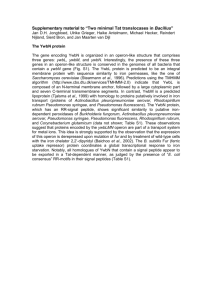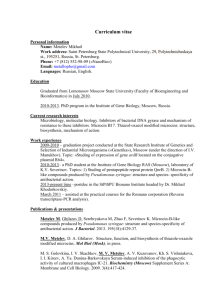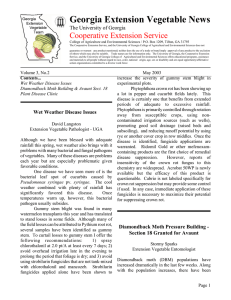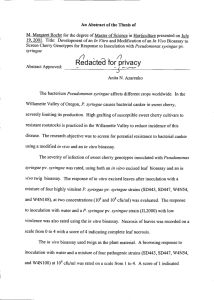doc - Environmental Protection Authority
advertisement
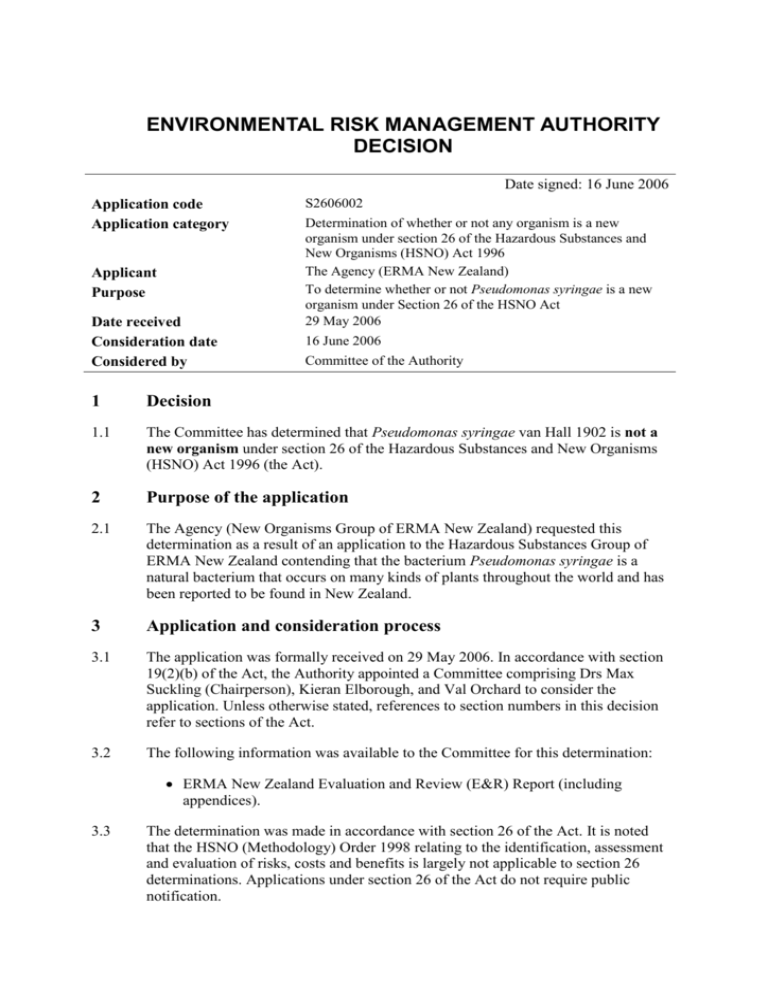
ENVIRONMENTAL RISK MANAGEMENT AUTHORITY DECISION Date signed: 16 June 2006 Application code Application category Applicant Purpose Date received Consideration date Considered by S2606002 Determination of whether or not any organism is a new organism under section 26 of the Hazardous Substances and New Organisms (HSNO) Act 1996 The Agency (ERMA New Zealand) To determine whether or not Pseudomonas syringae is a new organism under Section 26 of the HSNO Act 29 May 2006 16 June 2006 Committee of the Authority 1 Decision 1.1 The Committee has determined that Pseudomonas syringae van Hall 1902 is not a new organism under section 26 of the Hazardous Substances and New Organisms (HSNO) Act 1996 (the Act). 2 Purpose of the application 2.1 The Agency (New Organisms Group of ERMA New Zealand) requested this determination as a result of an application to the Hazardous Substances Group of ERMA New Zealand contending that the bacterium Pseudomonas syringae is a natural bacterium that occurs on many kinds of plants throughout the world and has been reported to be found in New Zealand. 3 Application and consideration process 3.1 The application was formally received on 29 May 2006. In accordance with section 19(2)(b) of the Act, the Authority appointed a Committee comprising Drs Max Suckling (Chairperson), Kieran Elborough, and Val Orchard to consider the application. Unless otherwise stated, references to section numbers in this decision refer to sections of the Act. 3.2 The following information was available to the Committee for this determination: ERMA New Zealand Evaluation and Review (E&R) Report (including appendices). 3.3 The determination was made in accordance with section 26 of the Act. It is noted that the HSNO (Methodology) Order 1998 relating to the identification, assessment and evaluation of risks, costs and benefits is largely not applicable to section 26 determinations. Applications under section 26 of the Act do not require public notification. 3.4 In accordance with section 26(2)(b) of the Act, the Department of Conservation (DoC) and the Ministry of Agriculture and Forestry Biosecurity New Zealand (MAF BNZ) were informed of the application and asked to comment. 3.5 DoC commented: “The Department is aware that Pseudomonas syringae is commonly found in the New Zealand environment and is a common pest in the horticulture industry”. 3.6 MAF BNZ commented: “MAF Biosecurity New Zealand is of the view that Pseudomonas syringae is a not new organism to New Zealand and agrees with the evidence provided in Pennycook (1989)”. 4 Reasons for the decision 4.1 For an organism to be determined as being a new organism under section 26 of the Act, the organism must be shown to meet one of the criteria in section 2A(1) of the Act defining a new organism. In the case of Pseudomonas syringae, the Committee first considered the criterion that: This species was present in New Zealand immediately before 29 July 1998 (section 2A(1)(a)). 4.2 Taking into account the information in the E&R report and comments from DoC and MAF BNZ noted in sections 3.5-3.6 above, the Committee considered that there is sufficient evidence to show that Pseudomonas syringae does not meet the definition of a new organism as defined in section 2A(1)(a) as this species was present in the uncontrolled New Zealand environment since before 29 July 1998. 4.3 The Committee considered that remaining definitions of a new organism in section 2A were not relevant to this determination. 4.4 The Committee followed the decision path set out in Appendix 1 of the E&R Report. 5 Conclusion 5.1 In accordance with section 26 of the HSNO Act 1996 and having regard to the information provided by all relevant parties, as detailed above, the Committee determines that Pseudomonas syringae van Hall 1902 is not a new organism for the purposes of the HSNO Act 1996, and directs that this decision be enacted by notice in the New Zealand Gazette. _____________________ 16 June 2006 Dr Max Suckling Date Chair, New Organisms Standing Committee of the Authority Environmental Risk Management Authority Determination: S2606001 Page 2 of 2

